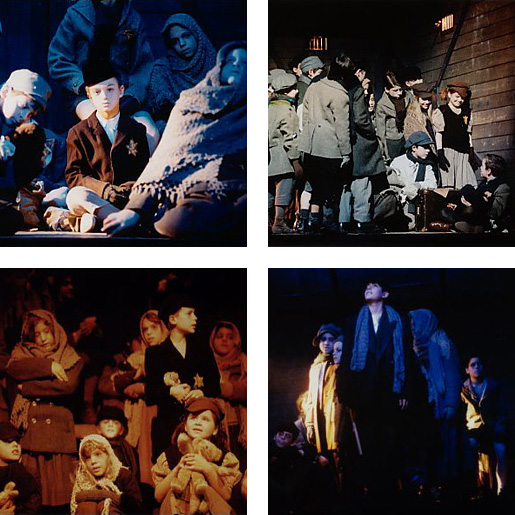
Brundibár – Prologue, Scene and Epilogue
Genre: Three scenes by Dominique Caillat provide a dramatic framework to Hans Krása’s opera Brundibár, taking the public back to the Theresienstadt (Terezin) concentration camp, where the work established its tragic fame.
Summary:
A child discovers items in an old suitcase and questions her mother, who remembers the performances of Brundibár in which she took part as a child in Terezin, and the subsequent deportation of most children to Auschwitz. She imagines that on their way by train to the death camp, they give a last performance of the opera in order overcome their fear.
Cast:
One adult actress (spoken part) and the children of the Brundibár cast.
Length:
Prologue and epilogue: ca. 25 Minutes. Brundibár opera: ca. 25 Minutes.
Music: orchestra and children's choir.
Public: children 8+ and adults.
Source:
For his 1999 production of Brundibár at the Viennese Chamber Opera, Michael Sturm wished to focus on the Terezin camp, where Brundibár was premiered by inmates during the war and performed 55 times. He wished the performance to take place in a train wagon on the way to the death camps. The Chamber Opera commissioned Dominique Caillat, who had made herself a name with her Terezin play Goodbye Butterfly, to write a few scenes embodying this idea. The author endeavoured to find a poetic solution, focussing on the role played by fantasy in the struggle against adversity.
Performances:
1999 Viennese Chamber Opera. Revival in 2000 for the ORF (life broadcast)
Brundibár:
Composer Hans Krása and librettist Adolf Hoffmeister wrote Brundibár in 1938 for a government competition, but the competition was later cancelled due to political developments. Rehearsals started in 1941 at the Jewish orphanage in Prague, which served as a temporary educational facility for children separated from their parents by the war. In the winter of 1942 the opera was rehearsed up to a dress rehearsal at the orphanage. But by this time, Krása and set designer Frantisek Zelenka had already been transported to Theresienstadt. By July of 1943, nearly all of the children of the original chorus and the orphanage staff had also been transported to Theresienstadt. Only the librettist Hoffmeister was fortunate to escape Prague in time. Reunited with the cast in Theresienstadt, Krása reconstructed the full score of the opera, based on memory and the partial piano score that remained in his hands, adapting it to suit the musical instruments available in the camp: flute, clarinet, guitar, accordion, piano, percussion, four violins, a cello and a double bass. A set was once again designed by Frantisek Zelenka, formerly a stage manager at the Czech National Theatre: several flats were painted as a background, in the foreground was a fence with drawings of the cat, dog and lark and holes for the singers to insert their heads in place of the animals' heads. On September 23rd, 1943 Brundibár premiered in Theresienstadt. The production was directed by Zelenka and choreographed by Camilla Rosenbaum, and was shown 55 times in the following year.
Reviews:
“A most cleverly conceived Prologue by Dominique Caillat leads into the opera… A story subtly told, devoid of heaviness…When the narrator finally wishes that stars never have to be worn again, it is the end of a moving and in every moment inspired production of the Viennese Chamber Opera.”
(Der Kurier)
“A prologue and epilogue serve as a setting for Brundibár… The children overcome their helplessness with the power of fantasy… A moving encounter with a sad piece of history.”
(Der Standard)
(Neue Kronen Zeiung)
